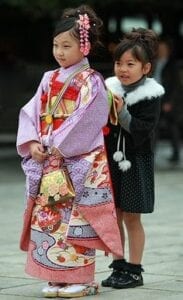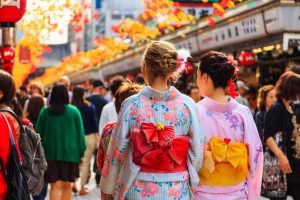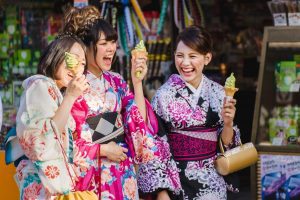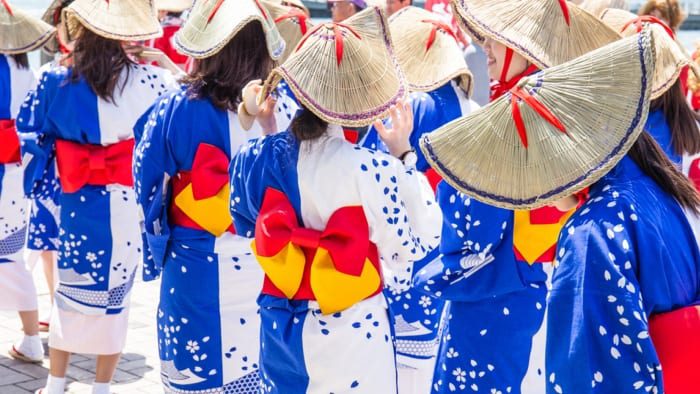
- Birth of a Child – Wearing Kimonos:
The birth of a child is a significant milestone in Japanese culture. When the child reaches the age of 30 to 100 days, the family visits a specific shrine to commemorate the occasion, known as “miyamairi.” Baby girls are adorned in brightly colored velvet kimonos, while baby boys wear black kimonos embellished with the family crest.
- Shichi-Go-San Festival:
The “Shichi-Go-San” festival, held on November 15, celebrates Japan’s children. Parents dress their 3-year-old and 5-year-old sons, and 3-year-old and 7-year-old daughters in kimonos and take them to a Shinto shrine to pray for good fortune and health. These ages hold cultural significance in a child’s growth, as odd numbers are considered lucky in Japan. The age of three marks the end of head-shaving for both boys and girls. Boys wear their first hakama and haori at the age of five, while girls receive their first obi, the traditional silk kimono belt, at the age of seven. Until then, girls tie their kimonos with a simple cord.

- Coming-of-Age Day – Wearing Kimonos:
On the second Monday in January, Japan celebrates young men and women turning twenty on Coming-of-Age Day. Women dress in zori sandals and furisode, a colorful kimono with exceptionally long sleeves. Men wear a traditional dark kimono with hakama and a haori jacket. Despite the formality of the traditional attire, Coming-of-Age Day often involves parties and drinking that extend late into the night, akin to homecoming or prom celebrations.

- Weddings – Wearing Kimonos:
Japanese weddings feature a traditional garment for the bride. She wears a shiromuku, an all-white ultra-formal kimono, and a tsunokakushi, a Japanese wedding headpiece, symbolizing purity and new beginnings. The shiromuku may also have white-on-white embroidery of animals like the phoenix, symbolizing femininity, elegance, and nobility. During the reception, brides can wear an uchikake, a brilliantly colorful kimono left untied. The groom typically wears several layers, including kimono undergarments, a black and white kimono with the family crest, and a haori with hakama pants as outerwear. Female relatives and friends of the bride wear furisode or tomesode, depending on their marital status.
- Parties and Personal Ceremonies – Wearing Kimonos:
For formal parties and traditional Japanese ceremonies like flower arranging and tea ceremonies, the “tsukesage” is the historical kimono of choice. It features patterns extending along the hemlines and sleeves, offering an elegantly subdued option compared to more brilliant and heavily patterned kimonos. The “houmongi,” meaning “visiting kimono,” is worn by women for formal visits to friends and colleagues. For any inquiries, feel free to email us.
These traditional occasions showcase the enduring significance and charm of kimono attire in Japanese culture.




